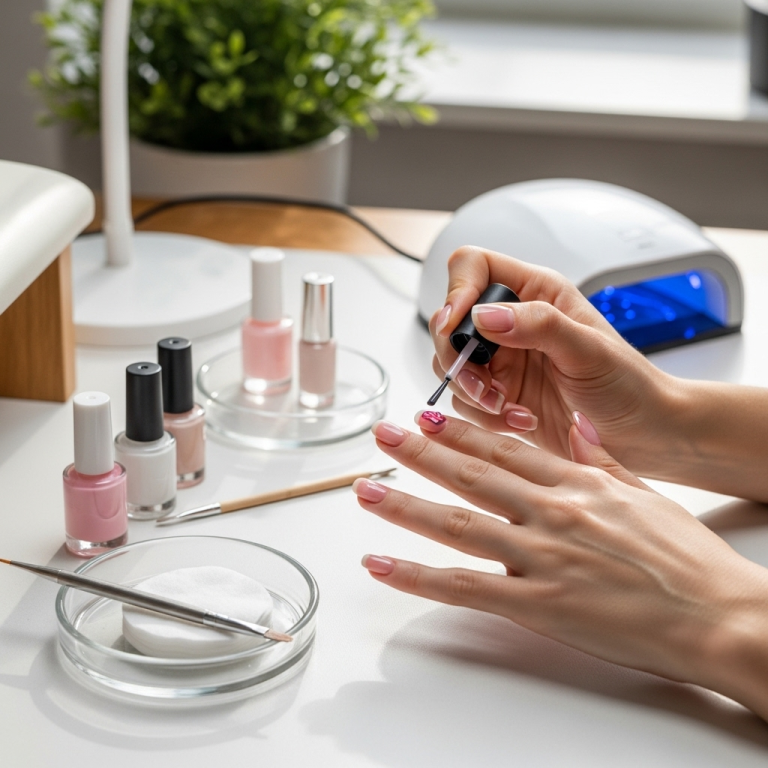Create stunning marble effect nails at home! This beginner-friendly guide breaks down the simple steps for achieving elegant, marbled nail art using everyday tools. Learn techniques for different marble looks and tips for a flawless finish.
Welcome, nail enthusiasts! Ever scroll through your feed and feel a pang of envy at those gorgeous, swirled marble nails? They look so chic and sophisticated, right? But the good news is, achieving that elegant marble finish on your own nails is totally doable, even if you’re just starting out! Forget complicated techniques; we’re going to break down a super simple way to get that luxe marble look right at your fingertips. Get ready to impress yourself and everyone else with your beautiful, DIY marble nails. Let’s dive in and unleash your inner nail artist!
Your Marble Effect Nails Toolkit
Before we get our hands (or nails!) dirty, let’s gather the essentials. Having the right tools makes all the difference in achieving that smooth, professional-looking marble effect. Don’t worry if you don’t have everything – we’ll offer some beginner-friendly alternatives!
Here’s what you’ll need:
Base Coat: This protects your natural nails and helps your polish adhere better.
Your Chosen Nail Polish Colors: Think neutrals like white, black, grey, or beige for a classic look. You can also experiment with blues, pinks, or greens!
A Thin Nail Art Brush or Toothpick: This is your magic wand for creating the marble swirls.
A Clean-Up Brush: An old, flat eyeliner brush or a small angled brush works perfectly for tidying up edges.
Rubbing Alcohol or Top Coat: This is key for blending the colors and creating that dreamy marble effect.
Top Coat: To seal your design and give it a glossy finish.
Let’s talk briefly about the magic ingredient for creating the swirls: your chosen liquid. While many tutorials use a special marbling liquid, we’re going for a super accessible method.
Rubbing Alcohol Method: This is fantastic for beginners! It works by diluting the polish slightly, allowing it to spread and marble beautifully.
Top Coat Method: If you prefer not to use alcohol, a good, glossy top coat can also be used to blend the polish. It creates a slightly thicker, more controlled swirl.
We’ll go through both methods so you can pick what works best for you!
The Classic Marble Effect: Step-by-Step Tutorial
This is the method most people think of when they hear “marble nails.” It’s elegant, timeless, and surprisingly easy to master. We’ll be using the rubbing alcohol technique here, as it’s a great starting point for its forgiving nature.
Step 1: Prep Your Canvas
First things first, make sure your nails are clean and dry. Gently push back your cuticles and file your nails to your desired shape. Apply a thin layer of your favorite base coat and let it dry completely. This is crucial for a long-lasting manicure.
Step 2: Lay Down Your Base Color
Paint your nails with your chosen base color. This is usually a lighter shade, like white or a soft off-white. Apply one or two thin coats, depending on the opacity of the polish, and let it dry completely to the touch. A perfectly smooth base is key to a stunning marble finish.
Step 3: Prepare Your Marble Swirls
Now for the fun part! Grab your darker polish (black is a classic, but feel free to experiment!) and dab a few small drops onto a non-porous surface like a piece of foil or a palette. Don’t make them too big – a little goes a long way.
Next, grab your rubbing alcohol. You’ll want to have a small dish of it ready. (If you’re using the top coat method, have that ready instead.)
Step 4: Create the Marble Magic!
For the Rubbing Alcohol Method: Dip your clean nail art brush or toothpick into the rubbing alcohol. Just a quick dip to get the tip slightly damp.
For the Top Coat Method: Dip your brush or toothpick into your clear top coat.
Now, gently touch the tip of your alcohol- or top-coat-dampened brush/toothpick to one of the drops of dark polish. You’ll see the polish start to expand and soften.
Immediately, while the polish is still wet and actively spreading, use your brush/toothpick to “draw” thin, irregular lines into the wet polish on your nail. Think of it like swirling cream into coffee, but with nail polish! Don’t overwork it. A few quick, delicate strokes are all you need to create those beautiful, organic-looking veins.
Pro Tip: If the polish starts to dry too quickly, simply add another tiny drop of alcohol or top coat to your brush and continue swirling. It’s all about quick, gentle movements.
Step 5: Refine and Perfect
Take a moment to admire your handiwork! If any areas look too bold or you want to blend them a little more, you can gently swirl again with a clean, slightly alcohol/top-coat-dampened brush. Remember, marble is naturally imperfect, so don’t strive for absolute symmetry.
Step 6: Seal the Deal
Once you’re happy with your marble design, it’s time to seal it in. Apply a generous layer of clear top coat over the entire nail. This not only protects your art but also smoothes out any slight texture and gives your marble nails that high-gloss, professional finish. Make sure to cap the free edge of your nail by running your brush along the tip to prevent chipping.
Step 7: Clean Up Any Mishaps
Use your clean-up brush dipped in a little nail polish remover (or rubbing alcohol can work in a pinch!) to carefully clean any polish that might have gotten onto your skin or cuticles. This step makes a huge difference in the overall polished look.
And there you have it! Your very own, stunning marble-effect nails.
Variations on the Marble Theme
Once you’ve mastered the classic marble, why stop there? The beauty of nail art is in its endless possibilities. Here are a few variations to inspire your next DIY manicure:
1. Color Block Marble
Instead of just two colors, try incorporating three or four. Start with a base color, then add veins of two different colors using the swirling technique described above. This can create a more dynamic and eye-catching look.
Base: A neutral like nude or light grey.
Veins: Teal and gold glitter polish.
Technique: A few careful swirls of teal and gold, blending them gently into each other.
2. Glitter Marble
Kick up the sparkle with a glitter polish! You can use a glitter polish as one of your “vein” colors, or even add a layer of fine glitter over the entire design before your top coat for an all-over shimmer.
Base: Black.
Veins: White and a fine silver glitter polish.
Technique: Swirl white polish and then gently drag the glitter polish through it.
3. Ombre Marble
This is a bit more advanced but incredibly chic. Start with an ombre base (e.g., white fading into grey) and then add delicate marble veins in a contrasting color.
Base: White to light pink ombre.
Veins: Black or deep grey.
Technique: Apply the ombre base first, let it dry, and then carefully add thin black marble lines on top.
4. Abstract Marble
Don’t feel confined to just veins! You can use a slightly firmer hand with your brush to create more abstract shapes and splatters that still mimic the fluid look of marble. Think less “veining” and more “fluid art.”
Marble Effect Nail Designs: Inspiration & Ideas
Marble effect nails aren’t just for a classic look; they can be incredibly versatile! Whether you’re heading to a formal event or just want to add a touch of elegance to your everyday look, there’s a marble design for you.
Monochromatic Sophistication: Stick to shades of grey, white, and black for a sleek, modern vibe. This works beautifully for professional settings.
Pastel Dreams: Soft pinks, blues, and lavenders create a dreamy, feminine marble. Perfect for spring and summer!
Bold & Beautiful: Don’t shy away from deep jewel tones like emerald green, sapphire blue, or amethyst purple. These make a statement!
Metallic Accents: Combine your marble with metallic polishes. Think gold foil flakes scattered over a white and grey marble, or a rose gold glitter polish swirled in.
Accent Nail Magic: Not ready for all-over marble? Try it on just one or two accent nails. Pair it with a solid complementary color on your other nails.
Debunking Marble Nail Myths
Sometimes, nail art can seem intimidating because of myths or misconceptions. Let’s clear a few things up about marble effect nails:
Myth: You need special, expensive tools.
Fact: As we’ve shown, a simple toothpick or thin brush, along with everyday nail polishes and rubbing alcohol or top coat, is all you really need to get started!
Myth: It’s too difficult for beginners.
Fact: While some intricate marble designs exist, the basic technique is surprisingly forgiving and easy to learn. Our step-by-step guide is designed for you!
Myth: Marble nails chip easily.
Fact: Like any manicure, marble nails can chip if not applied correctly. Proper nail prep, a good base coat, and a solid top coat (with edge capping!) are key to durability.
Myth: You can’t achieve a smooth finish at home.
Fact: With practice and the right technique (especially that final top coat!), you can achieve a glassy-smooth, professional-looking finish right from your own home.
Frequently Asked Questions About Marble Effect Nails
Here are some common questions beginners have about creating marble effect nails.
| Question | Answer |
|---|---|
| What are the best colors for marble nails? | Classic combinations include white and black, grey and white, or navy and white. You can also use pastels like pink and mint green, or jewel tones like deep teal and gold. The key is choosing colors that have enough contrast to create visible swirls, yet complement each other. |
| How long does it take to do marble nails? | For beginners, plan for about 30-45 minutes per hand. As you get more practice, you can likely speed up to 20-30 minutes. Drying time between coats is the main factor. |
| Can I use regular nail polish for marbling? | Yes! Regular nail polish is perfect for this technique. The key is how you manipulate the polish with a solvent (like alcohol) or top coat to create the swirls. Gel polish can also be used, but requires a UV/LED lamp and a slightly different technique. |
| My marble veins look too thick. How can I make them thinner? | Use a very fine nail art brush or a toothpick. For the rubbing alcohol method, dip your brush/toothpick in alcohol but immediately touch it to the polish drop and then to your nail. The less polish you pick up on the brush, the thinner the veins will be. For the top coat method, simply use less top coat on your brush. |
| How do I get my marble effect to look less like stripes and more like a natural stone pattern? | The key is imperfection! Avoid making your swirls perfectly uniform or symmetrical. Use quick, delicate strokes and don’t over-blend. Marble naturally has irregular patterns, so embrace the organic look. Sometimes, a very subtle secondary swirl can break up uniformity. |
| Can I use acetone to create marble effects? | While acetone-based polish removers can be used for clean-up, they aren’t typically used as the direct solvent for creating the marble swirls themselves. Rubbing alcohol (isopropyl alcohol, 70% or higher) is preferred for its ability to gently dilute and spread nail polish for marbling without being too harsh or evaporating instantly, which helps with control. |
Caring for Your Marble Effect Manicure
To keep your beautiful marble nails looking fresh for as long as possible, a little care goes a long way!
Wear Gloves: When doing chores, especially washing dishes or anything involving harsh chemicals, wear rubber gloves. This is the number one way to protect your manicure from damage and fading.
Moisturize: Keep your cuticles and hands hydrated with a good cuticle oil and hand cream. Healthy nails and skin look their best!
Avoid Chipping: Try not to use your nails as tools to pry or scrape things open. This puts unnecessary stress on the edges and can lead to chips.
Touch-Ups: If you notice a tiny chip, you can sometimes carefully fill it with a bit of top coat. For larger chips, it might be time for a fresh mani!
Conclusion: Your Marble Masterpiece Awaits!
See? Creating those coveted marble effect nails at home is totally achievable with a little patience and the right steps. You’ve learned how to prep your nails, blend colors for that signature swirl, and seal your masterpiece for a lasting shine. Don’t be afraid to experiment with different color combinations and styles to find what truly speaks to your personal flair. Remember, nail art is all about self-expression and having fun. So grab your polishes, put on your favorite tunes, and get ready to rock some stunning, DIY marble nails that are sure to turn heads. Happy marbling!



